An Analysis of Health Determinants for Visually Impaired Populations
VerifiedAdded on 2020/04/29
|11
|2431
|730
Report
AI Summary
This report delves into the determinants of health for visually impaired individuals, focusing on biological, socio-economic, and behavioral factors. It examines the impact of age, genetics, and gender, highlighting the prevalence of visual impairments in aging populations and the influence of socio-economic status, particularly in relation to income and access to healthcare. The report explores cognitive and behavioral determinants, including societal discrimination and the lack of support, and discusses the physical environment, built environment, and social determinants impacting the visually impaired. Furthermore, it analyzes the Ottawa Charter for Health Promotion and suggests strategies such as building healthy public policies, creating supportive environments, and strengthening community action to address disparities and improve the well-being of this vulnerable population. The report concludes with future implications, emphasizing the need for collaborative efforts and acknowledging the potential for environmental restrictions and prejudices to affect the success of the strategies.

Running head: DETERMINANTS OF HEALTH
Determinants of health
Name of the student
Name of the university
Author note:
Determinants of health
Name of the student
Name of the university
Author note:
Paraphrase This Document
Need a fresh take? Get an instant paraphrase of this document with our AI Paraphraser
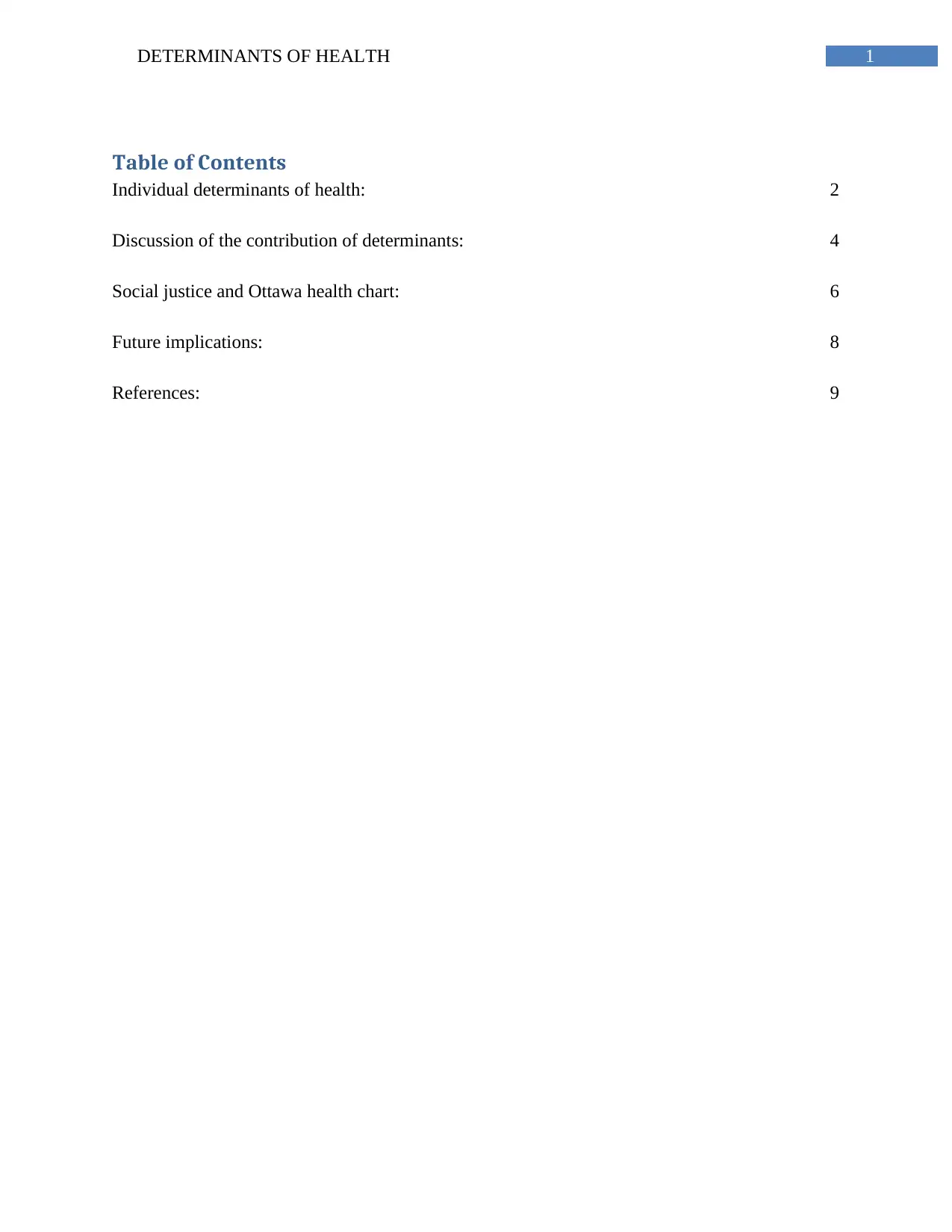
1DETERMINANTS OF HEALTH
Table of Contents
Individual determinants of health: 2
Discussion of the contribution of determinants: 4
Social justice and Ottawa health chart: 6
Future implications: 8
References: 9
Table of Contents
Individual determinants of health: 2
Discussion of the contribution of determinants: 4
Social justice and Ottawa health chart: 6
Future implications: 8
References: 9
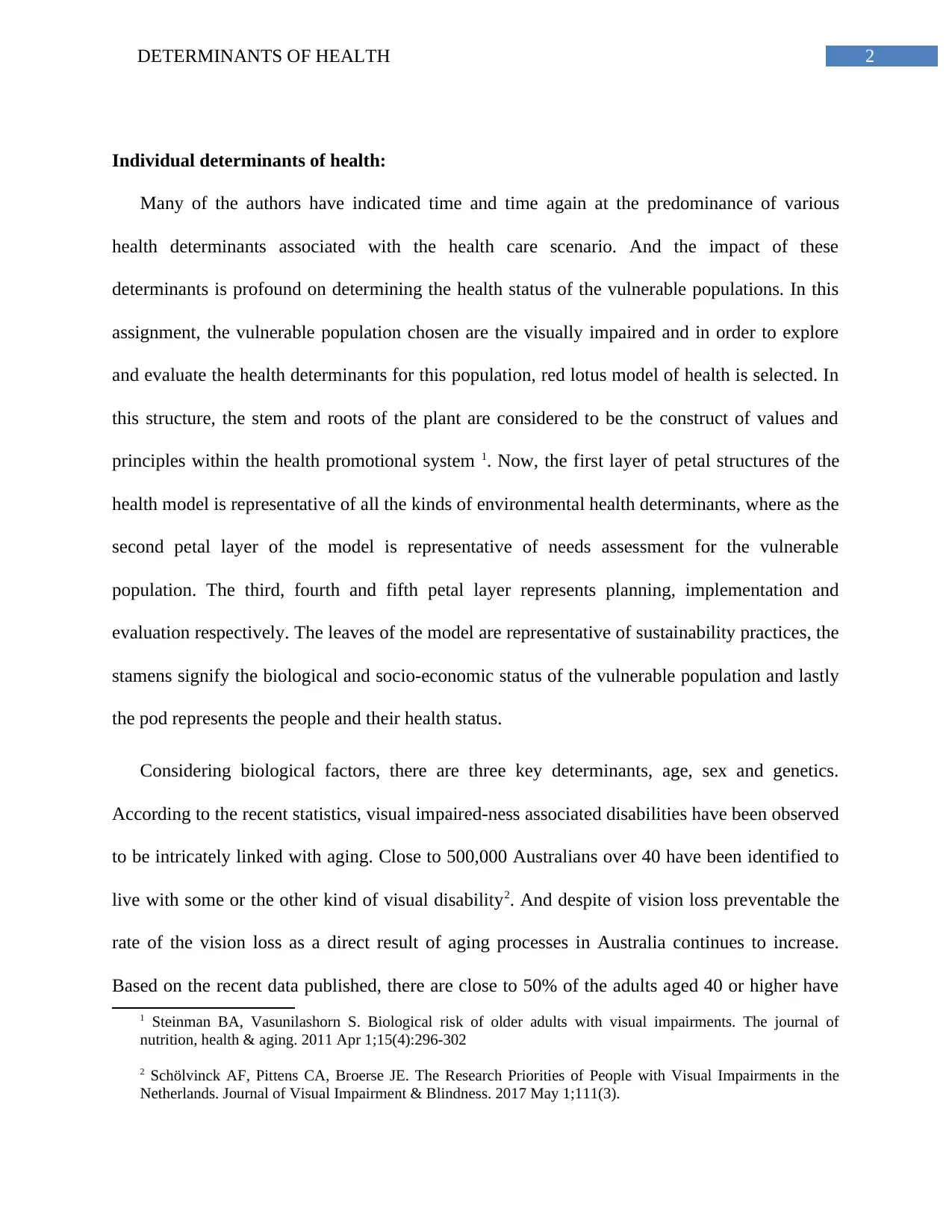
2DETERMINANTS OF HEALTH
Individual determinants of health:
Many of the authors have indicated time and time again at the predominance of various
health determinants associated with the health care scenario. And the impact of these
determinants is profound on determining the health status of the vulnerable populations. In this
assignment, the vulnerable population chosen are the visually impaired and in order to explore
and evaluate the health determinants for this population, red lotus model of health is selected. In
this structure, the stem and roots of the plant are considered to be the construct of values and
principles within the health promotional system 1. Now, the first layer of petal structures of the
health model is representative of all the kinds of environmental health determinants, where as the
second petal layer of the model is representative of needs assessment for the vulnerable
population. The third, fourth and fifth petal layer represents planning, implementation and
evaluation respectively. The leaves of the model are representative of sustainability practices, the
stamens signify the biological and socio-economic status of the vulnerable population and lastly
the pod represents the people and their health status.
Considering biological factors, there are three key determinants, age, sex and genetics.
According to the recent statistics, visual impaired-ness associated disabilities have been observed
to be intricately linked with aging. Close to 500,000 Australians over 40 have been identified to
live with some or the other kind of visual disability2. And despite of vision loss preventable the
rate of the vision loss as a direct result of aging processes in Australia continues to increase.
Based on the recent data published, there are close to 50% of the adults aged 40 or higher have
1 Steinman BA, Vasunilashorn S. Biological risk of older adults with visual impairments. The journal of
nutrition, health & aging. 2011 Apr 1;15(4):296-302
2 Schölvinck AF, Pittens CA, Broerse JE. The Research Priorities of People with Visual Impairments in the
Netherlands. Journal of Visual Impairment & Blindness. 2017 May 1;111(3).
Individual determinants of health:
Many of the authors have indicated time and time again at the predominance of various
health determinants associated with the health care scenario. And the impact of these
determinants is profound on determining the health status of the vulnerable populations. In this
assignment, the vulnerable population chosen are the visually impaired and in order to explore
and evaluate the health determinants for this population, red lotus model of health is selected. In
this structure, the stem and roots of the plant are considered to be the construct of values and
principles within the health promotional system 1. Now, the first layer of petal structures of the
health model is representative of all the kinds of environmental health determinants, where as the
second petal layer of the model is representative of needs assessment for the vulnerable
population. The third, fourth and fifth petal layer represents planning, implementation and
evaluation respectively. The leaves of the model are representative of sustainability practices, the
stamens signify the biological and socio-economic status of the vulnerable population and lastly
the pod represents the people and their health status.
Considering biological factors, there are three key determinants, age, sex and genetics.
According to the recent statistics, visual impaired-ness associated disabilities have been observed
to be intricately linked with aging. Close to 500,000 Australians over 40 have been identified to
live with some or the other kind of visual disability2. And despite of vision loss preventable the
rate of the vision loss as a direct result of aging processes in Australia continues to increase.
Based on the recent data published, there are close to 50% of the adults aged 40 or higher have
1 Steinman BA, Vasunilashorn S. Biological risk of older adults with visual impairments. The journal of
nutrition, health & aging. 2011 Apr 1;15(4):296-302
2 Schölvinck AF, Pittens CA, Broerse JE. The Research Priorities of People with Visual Impairments in the
Netherlands. Journal of Visual Impairment & Blindness. 2017 May 1;111(3).
⊘ This is a preview!⊘
Do you want full access?
Subscribe today to unlock all pages.

Trusted by 1+ million students worldwide
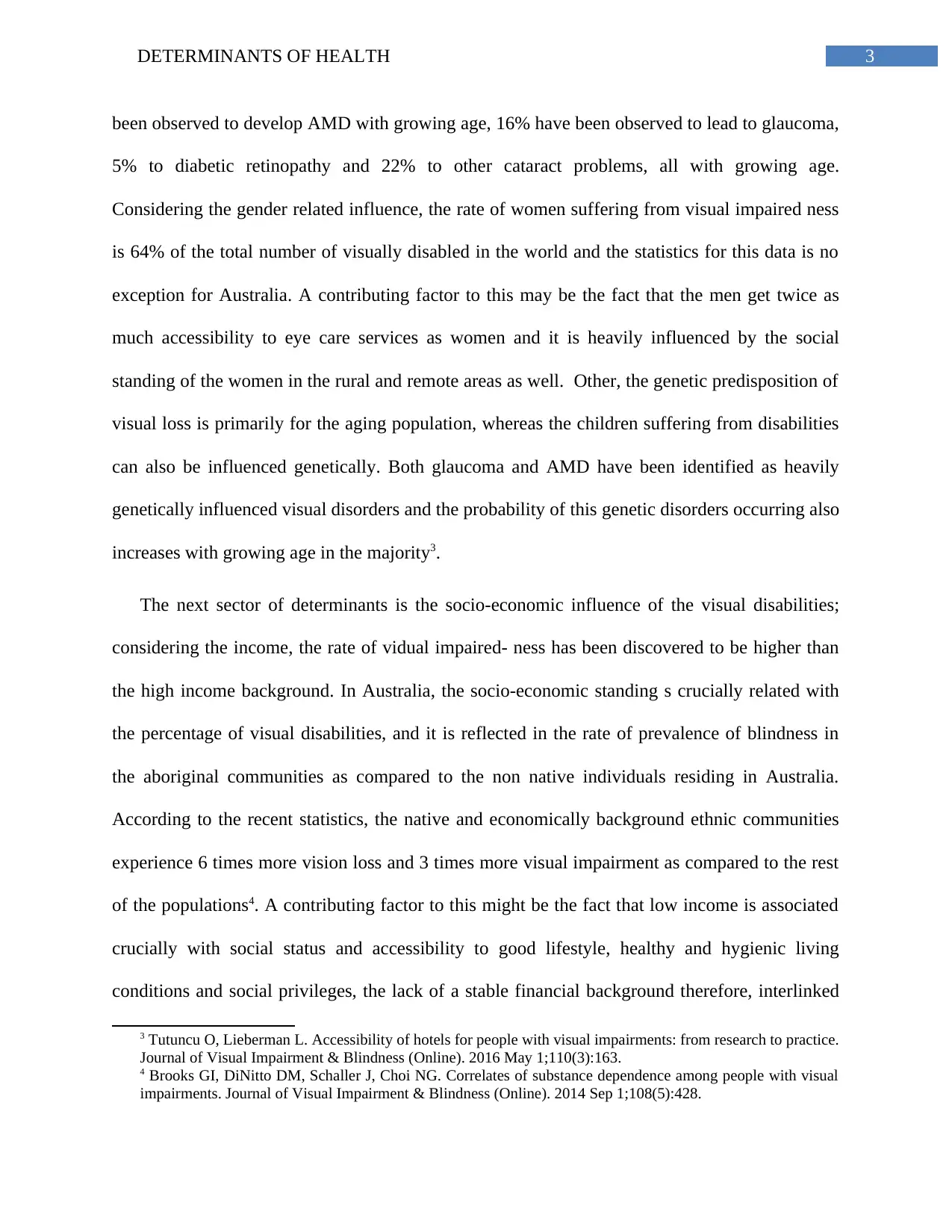
3DETERMINANTS OF HEALTH
been observed to develop AMD with growing age, 16% have been observed to lead to glaucoma,
5% to diabetic retinopathy and 22% to other cataract problems, all with growing age.
Considering the gender related influence, the rate of women suffering from visual impaired ness
is 64% of the total number of visually disabled in the world and the statistics for this data is no
exception for Australia. A contributing factor to this may be the fact that the men get twice as
much accessibility to eye care services as women and it is heavily influenced by the social
standing of the women in the rural and remote areas as well. Other, the genetic predisposition of
visual loss is primarily for the aging population, whereas the children suffering from disabilities
can also be influenced genetically. Both glaucoma and AMD have been identified as heavily
genetically influenced visual disorders and the probability of this genetic disorders occurring also
increases with growing age in the majority3.
The next sector of determinants is the socio-economic influence of the visual disabilities;
considering the income, the rate of vidual impaired- ness has been discovered to be higher than
the high income background. In Australia, the socio-economic standing s crucially related with
the percentage of visual disabilities, and it is reflected in the rate of prevalence of blindness in
the aboriginal communities as compared to the non native individuals residing in Australia.
According to the recent statistics, the native and economically background ethnic communities
experience 6 times more vision loss and 3 times more visual impairment as compared to the rest
of the populations4. A contributing factor to this might be the fact that low income is associated
crucially with social status and accessibility to good lifestyle, healthy and hygienic living
conditions and social privileges, the lack of a stable financial background therefore, interlinked
3 Tutuncu O, Lieberman L. Accessibility of hotels for people with visual impairments: from research to practice.
Journal of Visual Impairment & Blindness (Online). 2016 May 1;110(3):163.
4 Brooks GI, DiNitto DM, Schaller J, Choi NG. Correlates of substance dependence among people with visual
impairments. Journal of Visual Impairment & Blindness (Online). 2014 Sep 1;108(5):428.
been observed to develop AMD with growing age, 16% have been observed to lead to glaucoma,
5% to diabetic retinopathy and 22% to other cataract problems, all with growing age.
Considering the gender related influence, the rate of women suffering from visual impaired ness
is 64% of the total number of visually disabled in the world and the statistics for this data is no
exception for Australia. A contributing factor to this may be the fact that the men get twice as
much accessibility to eye care services as women and it is heavily influenced by the social
standing of the women in the rural and remote areas as well. Other, the genetic predisposition of
visual loss is primarily for the aging population, whereas the children suffering from disabilities
can also be influenced genetically. Both glaucoma and AMD have been identified as heavily
genetically influenced visual disorders and the probability of this genetic disorders occurring also
increases with growing age in the majority3.
The next sector of determinants is the socio-economic influence of the visual disabilities;
considering the income, the rate of vidual impaired- ness has been discovered to be higher than
the high income background. In Australia, the socio-economic standing s crucially related with
the percentage of visual disabilities, and it is reflected in the rate of prevalence of blindness in
the aboriginal communities as compared to the non native individuals residing in Australia.
According to the recent statistics, the native and economically background ethnic communities
experience 6 times more vision loss and 3 times more visual impairment as compared to the rest
of the populations4. A contributing factor to this might be the fact that low income is associated
crucially with social status and accessibility to good lifestyle, healthy and hygienic living
conditions and social privileges, the lack of a stable financial background therefore, interlinked
3 Tutuncu O, Lieberman L. Accessibility of hotels for people with visual impairments: from research to practice.
Journal of Visual Impairment & Blindness (Online). 2016 May 1;110(3):163.
4 Brooks GI, DiNitto DM, Schaller J, Choi NG. Correlates of substance dependence among people with visual
impairments. Journal of Visual Impairment & Blindness (Online). 2014 Sep 1;108(5):428.
Paraphrase This Document
Need a fresh take? Get an instant paraphrase of this document with our AI Paraphraser
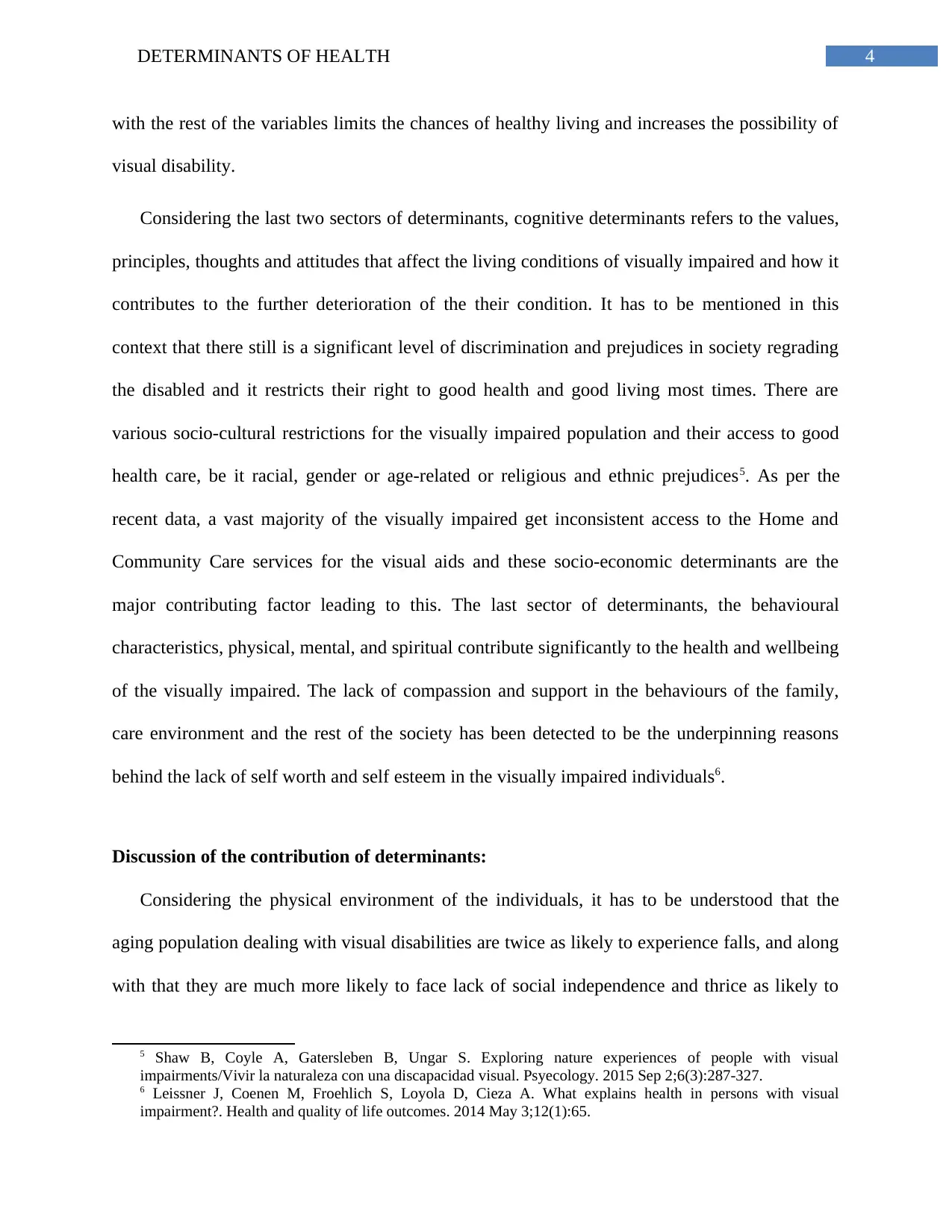
4DETERMINANTS OF HEALTH
with the rest of the variables limits the chances of healthy living and increases the possibility of
visual disability.
Considering the last two sectors of determinants, cognitive determinants refers to the values,
principles, thoughts and attitudes that affect the living conditions of visually impaired and how it
contributes to the further deterioration of the their condition. It has to be mentioned in this
context that there still is a significant level of discrimination and prejudices in society regrading
the disabled and it restricts their right to good health and good living most times. There are
various socio-cultural restrictions for the visually impaired population and their access to good
health care, be it racial, gender or age-related or religious and ethnic prejudices5. As per the
recent data, a vast majority of the visually impaired get inconsistent access to the Home and
Community Care services for the visual aids and these socio-economic determinants are the
major contributing factor leading to this. The last sector of determinants, the behavioural
characteristics, physical, mental, and spiritual contribute significantly to the health and wellbeing
of the visually impaired. The lack of compassion and support in the behaviours of the family,
care environment and the rest of the society has been detected to be the underpinning reasons
behind the lack of self worth and self esteem in the visually impaired individuals6.
Discussion of the contribution of determinants:
Considering the physical environment of the individuals, it has to be understood that the
aging population dealing with visual disabilities are twice as likely to experience falls, and along
with that they are much more likely to face lack of social independence and thrice as likely to
5 Shaw B, Coyle A, Gatersleben B, Ungar S. Exploring nature experiences of people with visual
impairments/Vivir la naturaleza con una discapacidad visual. Psyecology. 2015 Sep 2;6(3):287-327.
6 Leissner J, Coenen M, Froehlich S, Loyola D, Cieza A. What explains health in persons with visual
impairment?. Health and quality of life outcomes. 2014 May 3;12(1):65.
with the rest of the variables limits the chances of healthy living and increases the possibility of
visual disability.
Considering the last two sectors of determinants, cognitive determinants refers to the values,
principles, thoughts and attitudes that affect the living conditions of visually impaired and how it
contributes to the further deterioration of the their condition. It has to be mentioned in this
context that there still is a significant level of discrimination and prejudices in society regrading
the disabled and it restricts their right to good health and good living most times. There are
various socio-cultural restrictions for the visually impaired population and their access to good
health care, be it racial, gender or age-related or religious and ethnic prejudices5. As per the
recent data, a vast majority of the visually impaired get inconsistent access to the Home and
Community Care services for the visual aids and these socio-economic determinants are the
major contributing factor leading to this. The last sector of determinants, the behavioural
characteristics, physical, mental, and spiritual contribute significantly to the health and wellbeing
of the visually impaired. The lack of compassion and support in the behaviours of the family,
care environment and the rest of the society has been detected to be the underpinning reasons
behind the lack of self worth and self esteem in the visually impaired individuals6.
Discussion of the contribution of determinants:
Considering the physical environment of the individuals, it has to be understood that the
aging population dealing with visual disabilities are twice as likely to experience falls, and along
with that they are much more likely to face lack of social independence and thrice as likely to
5 Shaw B, Coyle A, Gatersleben B, Ungar S. Exploring nature experiences of people with visual
impairments/Vivir la naturaleza con una discapacidad visual. Psyecology. 2015 Sep 2;6(3):287-327.
6 Leissner J, Coenen M, Froehlich S, Loyola D, Cieza A. What explains health in persons with visual
impairment?. Health and quality of life outcomes. 2014 May 3;12(1):65.
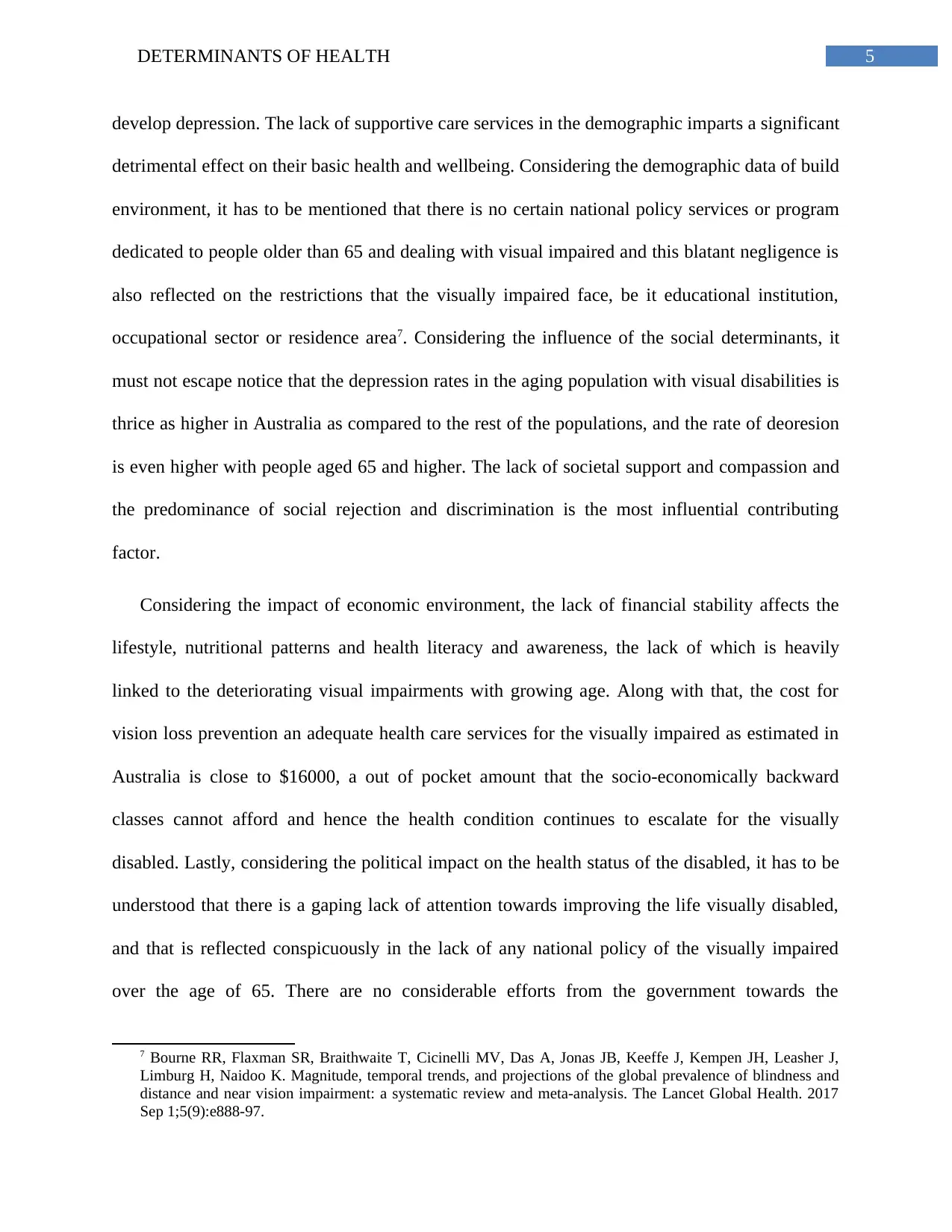
5DETERMINANTS OF HEALTH
develop depression. The lack of supportive care services in the demographic imparts a significant
detrimental effect on their basic health and wellbeing. Considering the demographic data of build
environment, it has to be mentioned that there is no certain national policy services or program
dedicated to people older than 65 and dealing with visual impaired and this blatant negligence is
also reflected on the restrictions that the visually impaired face, be it educational institution,
occupational sector or residence area7. Considering the influence of the social determinants, it
must not escape notice that the depression rates in the aging population with visual disabilities is
thrice as higher in Australia as compared to the rest of the populations, and the rate of deoresion
is even higher with people aged 65 and higher. The lack of societal support and compassion and
the predominance of social rejection and discrimination is the most influential contributing
factor.
Considering the impact of economic environment, the lack of financial stability affects the
lifestyle, nutritional patterns and health literacy and awareness, the lack of which is heavily
linked to the deteriorating visual impairments with growing age. Along with that, the cost for
vision loss prevention an adequate health care services for the visually impaired as estimated in
Australia is close to $16000, a out of pocket amount that the socio-economically backward
classes cannot afford and hence the health condition continues to escalate for the visually
disabled. Lastly, considering the political impact on the health status of the disabled, it has to be
understood that there is a gaping lack of attention towards improving the life visually disabled,
and that is reflected conspicuously in the lack of any national policy of the visually impaired
over the age of 65. There are no considerable efforts from the government towards the
7 Bourne RR, Flaxman SR, Braithwaite T, Cicinelli MV, Das A, Jonas JB, Keeffe J, Kempen JH, Leasher J,
Limburg H, Naidoo K. Magnitude, temporal trends, and projections of the global prevalence of blindness and
distance and near vision impairment: a systematic review and meta-analysis. The Lancet Global Health. 2017
Sep 1;5(9):e888-97.
develop depression. The lack of supportive care services in the demographic imparts a significant
detrimental effect on their basic health and wellbeing. Considering the demographic data of build
environment, it has to be mentioned that there is no certain national policy services or program
dedicated to people older than 65 and dealing with visual impaired and this blatant negligence is
also reflected on the restrictions that the visually impaired face, be it educational institution,
occupational sector or residence area7. Considering the influence of the social determinants, it
must not escape notice that the depression rates in the aging population with visual disabilities is
thrice as higher in Australia as compared to the rest of the populations, and the rate of deoresion
is even higher with people aged 65 and higher. The lack of societal support and compassion and
the predominance of social rejection and discrimination is the most influential contributing
factor.
Considering the impact of economic environment, the lack of financial stability affects the
lifestyle, nutritional patterns and health literacy and awareness, the lack of which is heavily
linked to the deteriorating visual impairments with growing age. Along with that, the cost for
vision loss prevention an adequate health care services for the visually impaired as estimated in
Australia is close to $16000, a out of pocket amount that the socio-economically backward
classes cannot afford and hence the health condition continues to escalate for the visually
disabled. Lastly, considering the political impact on the health status of the disabled, it has to be
understood that there is a gaping lack of attention towards improving the life visually disabled,
and that is reflected conspicuously in the lack of any national policy of the visually impaired
over the age of 65. There are no considerable efforts from the government towards the
7 Bourne RR, Flaxman SR, Braithwaite T, Cicinelli MV, Das A, Jonas JB, Keeffe J, Kempen JH, Leasher J,
Limburg H, Naidoo K. Magnitude, temporal trends, and projections of the global prevalence of blindness and
distance and near vision impairment: a systematic review and meta-analysis. The Lancet Global Health. 2017
Sep 1;5(9):e888-97.
⊘ This is a preview!⊘
Do you want full access?
Subscribe today to unlock all pages.

Trusted by 1+ million students worldwide
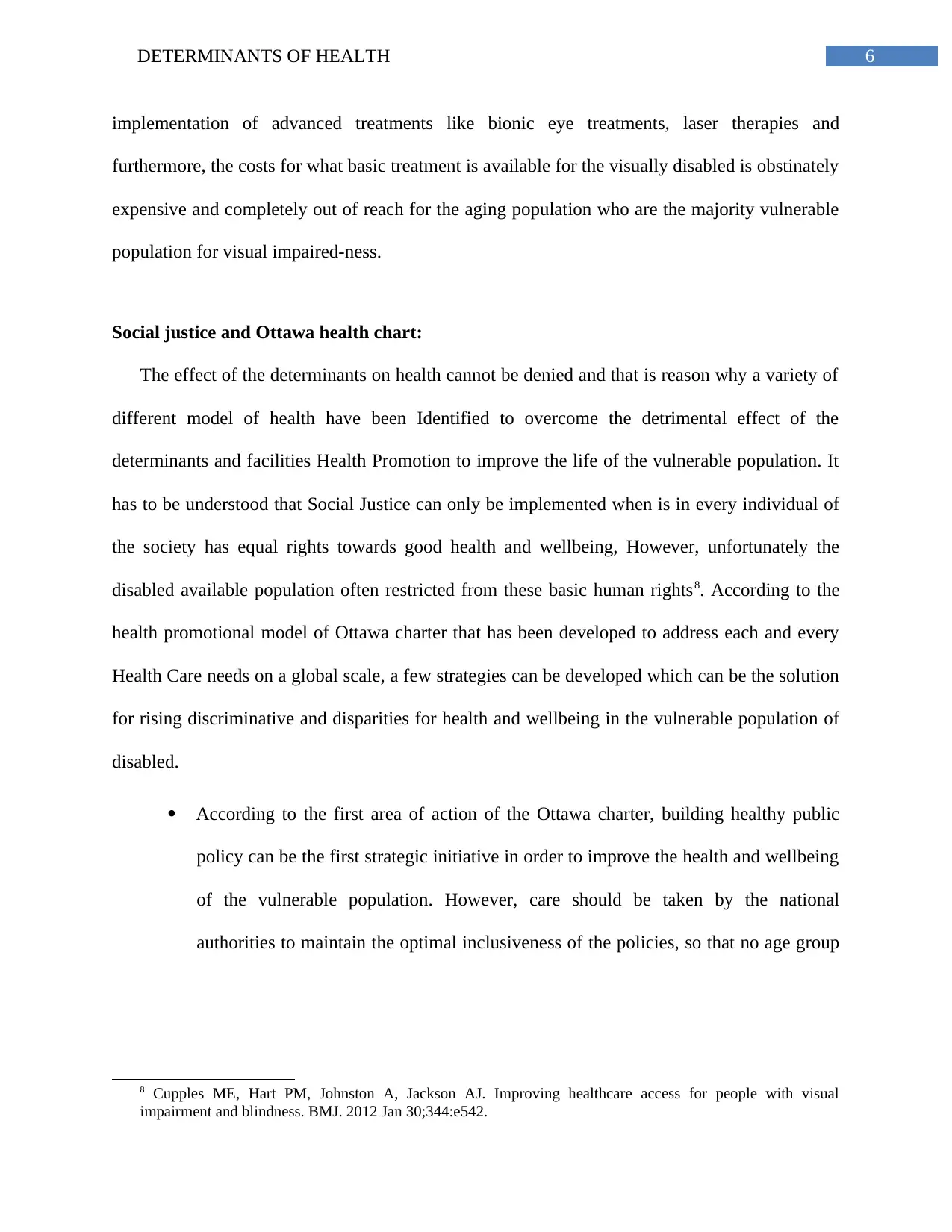
6DETERMINANTS OF HEALTH
implementation of advanced treatments like bionic eye treatments, laser therapies and
furthermore, the costs for what basic treatment is available for the visually disabled is obstinately
expensive and completely out of reach for the aging population who are the majority vulnerable
population for visual impaired-ness.
Social justice and Ottawa health chart:
The effect of the determinants on health cannot be denied and that is reason why a variety of
different model of health have been Identified to overcome the detrimental effect of the
determinants and facilities Health Promotion to improve the life of the vulnerable population. It
has to be understood that Social Justice can only be implemented when is in every individual of
the society has equal rights towards good health and wellbeing, However, unfortunately the
disabled available population often restricted from these basic human rights8. According to the
health promotional model of Ottawa charter that has been developed to address each and every
Health Care needs on a global scale, a few strategies can be developed which can be the solution
for rising discriminative and disparities for health and wellbeing in the vulnerable population of
disabled.
According to the first area of action of the Ottawa charter, building healthy public
policy can be the first strategic initiative in order to improve the health and wellbeing
of the vulnerable population. However, care should be taken by the national
authorities to maintain the optimal inclusiveness of the policies, so that no age group
8 Cupples ME, Hart PM, Johnston A, Jackson AJ. Improving healthcare access for people with visual
impairment and blindness. BMJ. 2012 Jan 30;344:e542.
implementation of advanced treatments like bionic eye treatments, laser therapies and
furthermore, the costs for what basic treatment is available for the visually disabled is obstinately
expensive and completely out of reach for the aging population who are the majority vulnerable
population for visual impaired-ness.
Social justice and Ottawa health chart:
The effect of the determinants on health cannot be denied and that is reason why a variety of
different model of health have been Identified to overcome the detrimental effect of the
determinants and facilities Health Promotion to improve the life of the vulnerable population. It
has to be understood that Social Justice can only be implemented when is in every individual of
the society has equal rights towards good health and wellbeing, However, unfortunately the
disabled available population often restricted from these basic human rights8. According to the
health promotional model of Ottawa charter that has been developed to address each and every
Health Care needs on a global scale, a few strategies can be developed which can be the solution
for rising discriminative and disparities for health and wellbeing in the vulnerable population of
disabled.
According to the first area of action of the Ottawa charter, building healthy public
policy can be the first strategic initiative in order to improve the health and wellbeing
of the vulnerable population. However, care should be taken by the national
authorities to maintain the optimal inclusiveness of the policies, so that no age group
8 Cupples ME, Hart PM, Johnston A, Jackson AJ. Improving healthcare access for people with visual
impairment and blindness. BMJ. 2012 Jan 30;344:e542.
Paraphrase This Document
Need a fresh take? Get an instant paraphrase of this document with our AI Paraphraser
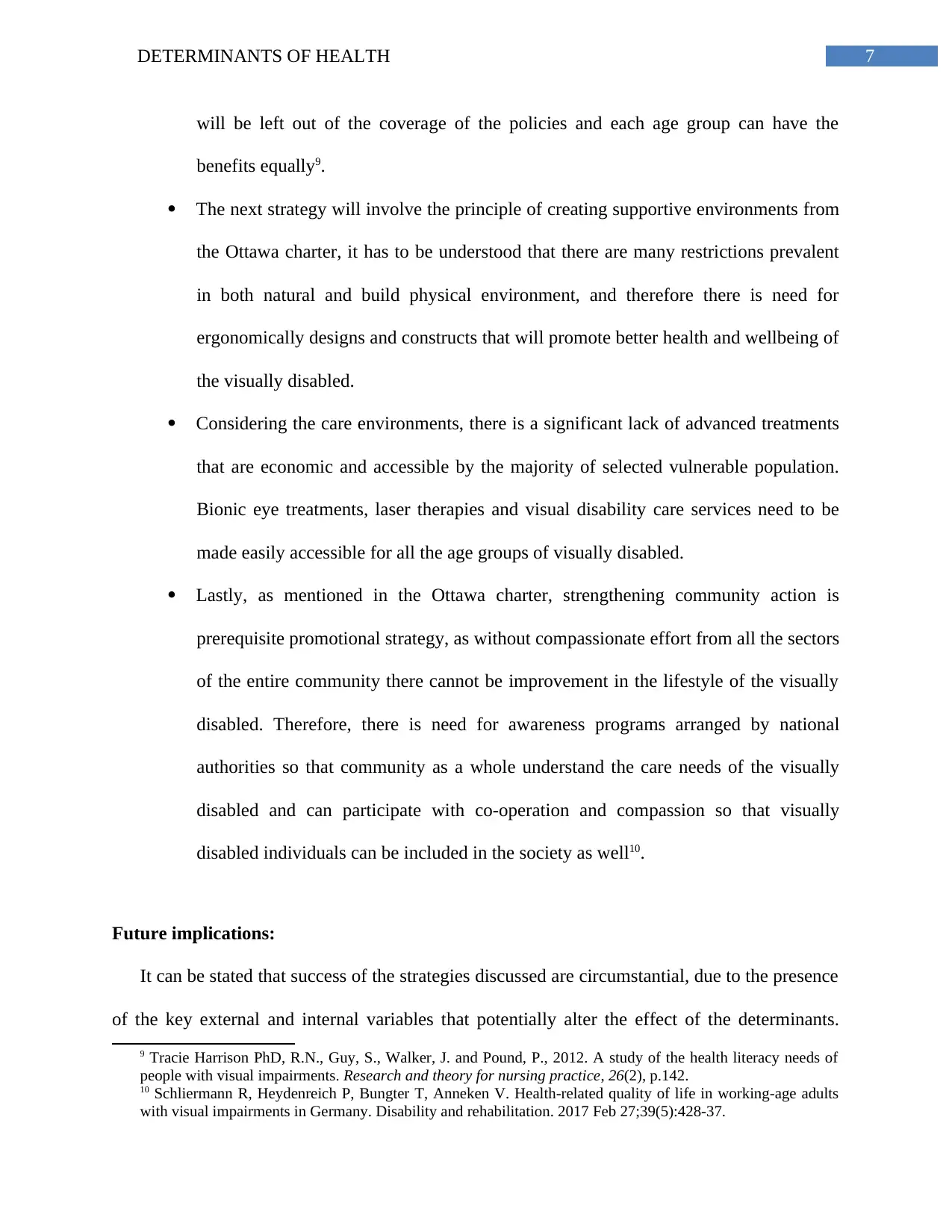
7DETERMINANTS OF HEALTH
will be left out of the coverage of the policies and each age group can have the
benefits equally9.
The next strategy will involve the principle of creating supportive environments from
the Ottawa charter, it has to be understood that there are many restrictions prevalent
in both natural and build physical environment, and therefore there is need for
ergonomically designs and constructs that will promote better health and wellbeing of
the visually disabled.
Considering the care environments, there is a significant lack of advanced treatments
that are economic and accessible by the majority of selected vulnerable population.
Bionic eye treatments, laser therapies and visual disability care services need to be
made easily accessible for all the age groups of visually disabled.
Lastly, as mentioned in the Ottawa charter, strengthening community action is
prerequisite promotional strategy, as without compassionate effort from all the sectors
of the entire community there cannot be improvement in the lifestyle of the visually
disabled. Therefore, there is need for awareness programs arranged by national
authorities so that community as a whole understand the care needs of the visually
disabled and can participate with co-operation and compassion so that visually
disabled individuals can be included in the society as well10.
Future implications:
It can be stated that success of the strategies discussed are circumstantial, due to the presence
of the key external and internal variables that potentially alter the effect of the determinants.
9 Tracie Harrison PhD, R.N., Guy, S., Walker, J. and Pound, P., 2012. A study of the health literacy needs of
people with visual impairments. Research and theory for nursing practice, 26(2), p.142.
10 Schliermann R, Heydenreich P, Bungter T, Anneken V. Health-related quality of life in working-age adults
with visual impairments in Germany. Disability and rehabilitation. 2017 Feb 27;39(5):428-37.
will be left out of the coverage of the policies and each age group can have the
benefits equally9.
The next strategy will involve the principle of creating supportive environments from
the Ottawa charter, it has to be understood that there are many restrictions prevalent
in both natural and build physical environment, and therefore there is need for
ergonomically designs and constructs that will promote better health and wellbeing of
the visually disabled.
Considering the care environments, there is a significant lack of advanced treatments
that are economic and accessible by the majority of selected vulnerable population.
Bionic eye treatments, laser therapies and visual disability care services need to be
made easily accessible for all the age groups of visually disabled.
Lastly, as mentioned in the Ottawa charter, strengthening community action is
prerequisite promotional strategy, as without compassionate effort from all the sectors
of the entire community there cannot be improvement in the lifestyle of the visually
disabled. Therefore, there is need for awareness programs arranged by national
authorities so that community as a whole understand the care needs of the visually
disabled and can participate with co-operation and compassion so that visually
disabled individuals can be included in the society as well10.
Future implications:
It can be stated that success of the strategies discussed are circumstantial, due to the presence
of the key external and internal variables that potentially alter the effect of the determinants.
9 Tracie Harrison PhD, R.N., Guy, S., Walker, J. and Pound, P., 2012. A study of the health literacy needs of
people with visual impairments. Research and theory for nursing practice, 26(2), p.142.
10 Schliermann R, Heydenreich P, Bungter T, Anneken V. Health-related quality of life in working-age adults
with visual impairments in Germany. Disability and rehabilitation. 2017 Feb 27;39(5):428-37.
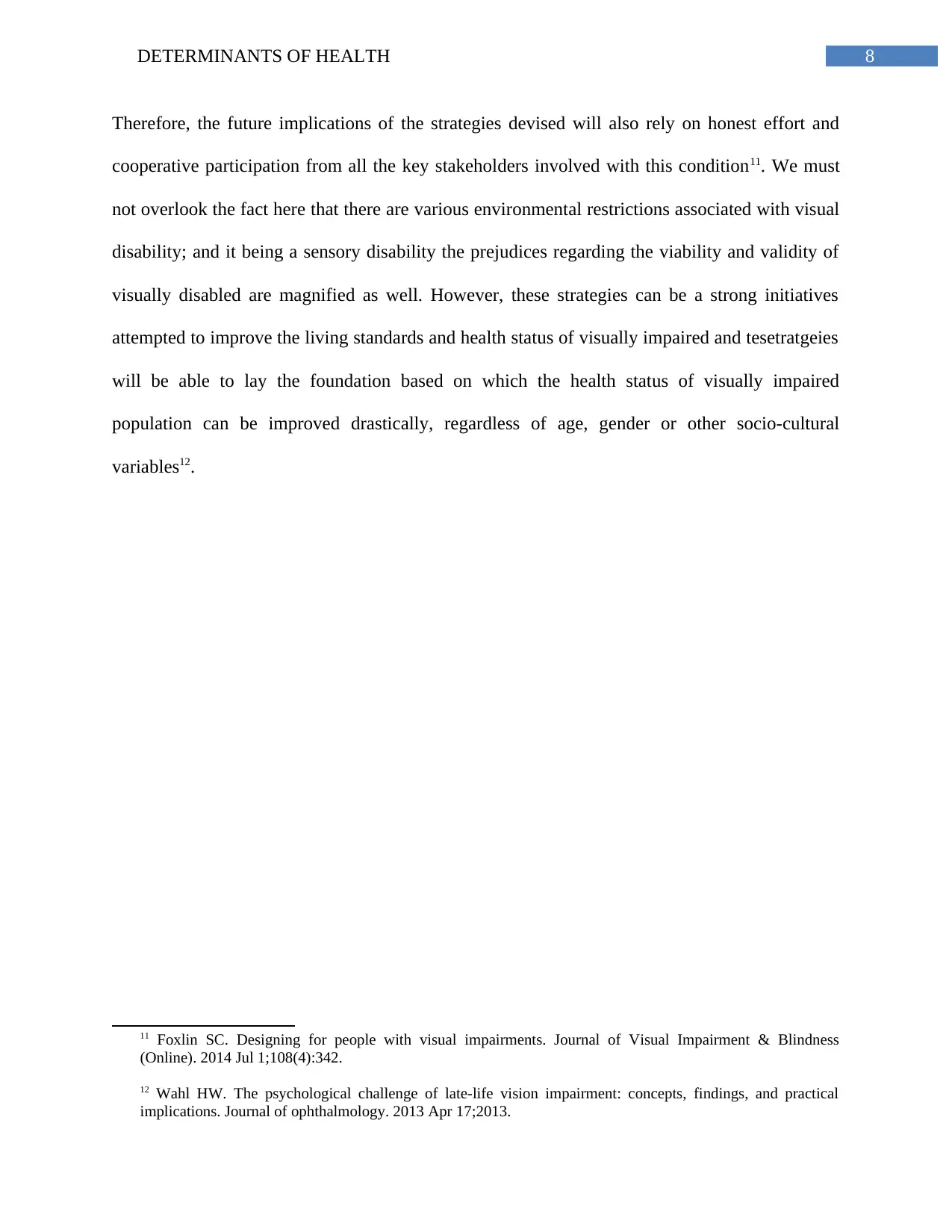
8DETERMINANTS OF HEALTH
Therefore, the future implications of the strategies devised will also rely on honest effort and
cooperative participation from all the key stakeholders involved with this condition11. We must
not overlook the fact here that there are various environmental restrictions associated with visual
disability; and it being a sensory disability the prejudices regarding the viability and validity of
visually disabled are magnified as well. However, these strategies can be a strong initiatives
attempted to improve the living standards and health status of visually impaired and tesetratgeies
will be able to lay the foundation based on which the health status of visually impaired
population can be improved drastically, regardless of age, gender or other socio-cultural
variables12.
11 Foxlin SC. Designing for people with visual impairments. Journal of Visual Impairment & Blindness
(Online). 2014 Jul 1;108(4):342.
12 Wahl HW. The psychological challenge of late-life vision impairment: concepts, findings, and practical
implications. Journal of ophthalmology. 2013 Apr 17;2013.
Therefore, the future implications of the strategies devised will also rely on honest effort and
cooperative participation from all the key stakeholders involved with this condition11. We must
not overlook the fact here that there are various environmental restrictions associated with visual
disability; and it being a sensory disability the prejudices regarding the viability and validity of
visually disabled are magnified as well. However, these strategies can be a strong initiatives
attempted to improve the living standards and health status of visually impaired and tesetratgeies
will be able to lay the foundation based on which the health status of visually impaired
population can be improved drastically, regardless of age, gender or other socio-cultural
variables12.
11 Foxlin SC. Designing for people with visual impairments. Journal of Visual Impairment & Blindness
(Online). 2014 Jul 1;108(4):342.
12 Wahl HW. The psychological challenge of late-life vision impairment: concepts, findings, and practical
implications. Journal of ophthalmology. 2013 Apr 17;2013.
⊘ This is a preview!⊘
Do you want full access?
Subscribe today to unlock all pages.

Trusted by 1+ million students worldwide
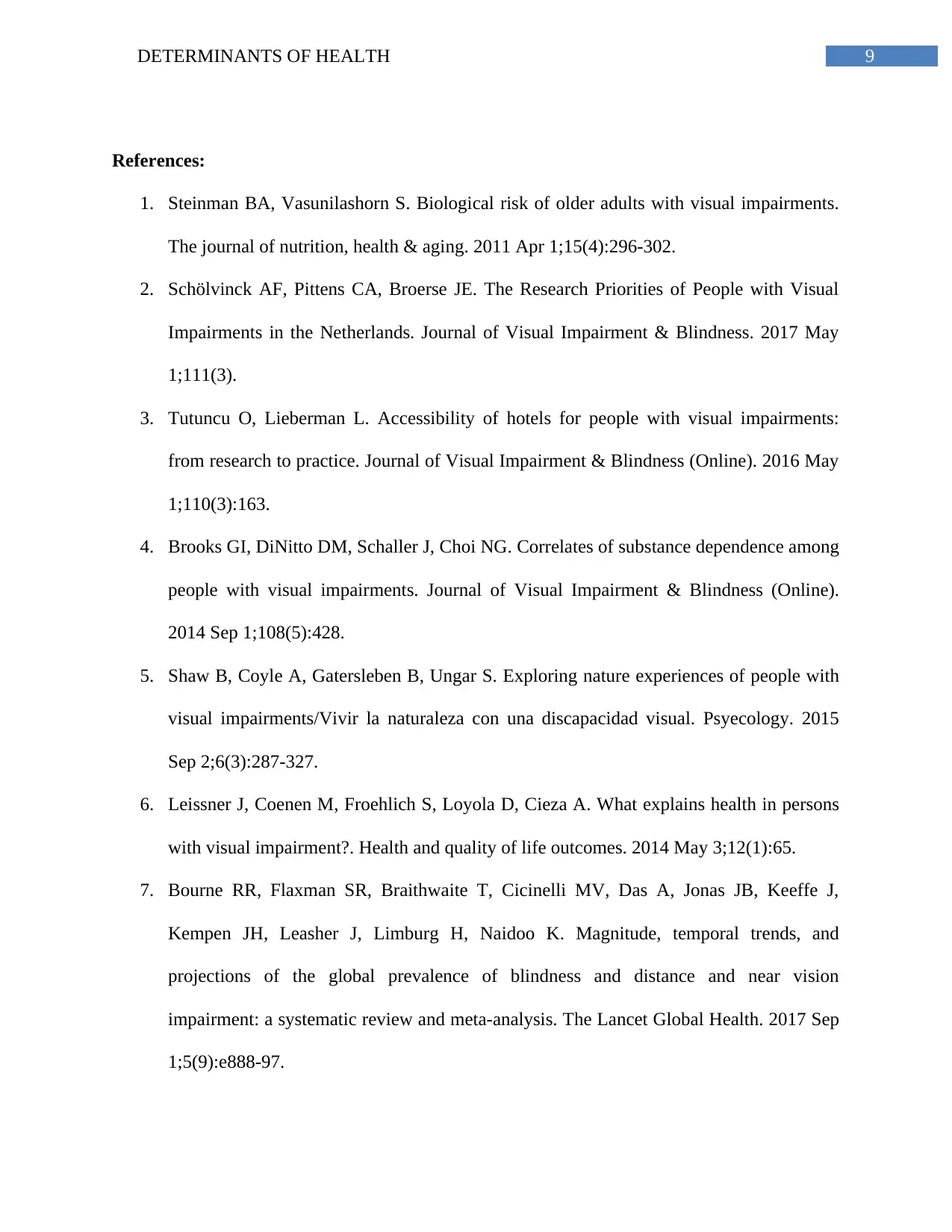
9DETERMINANTS OF HEALTH
References:
1. Steinman BA, Vasunilashorn S. Biological risk of older adults with visual impairments.
The journal of nutrition, health & aging. 2011 Apr 1;15(4):296-302.
2. Schölvinck AF, Pittens CA, Broerse JE. The Research Priorities of People with Visual
Impairments in the Netherlands. Journal of Visual Impairment & Blindness. 2017 May
1;111(3).
3. Tutuncu O, Lieberman L. Accessibility of hotels for people with visual impairments:
from research to practice. Journal of Visual Impairment & Blindness (Online). 2016 May
1;110(3):163.
4. Brooks GI, DiNitto DM, Schaller J, Choi NG. Correlates of substance dependence among
people with visual impairments. Journal of Visual Impairment & Blindness (Online).
2014 Sep 1;108(5):428.
5. Shaw B, Coyle A, Gatersleben B, Ungar S. Exploring nature experiences of people with
visual impairments/Vivir la naturaleza con una discapacidad visual. Psyecology. 2015
Sep 2;6(3):287-327.
6. Leissner J, Coenen M, Froehlich S, Loyola D, Cieza A. What explains health in persons
with visual impairment?. Health and quality of life outcomes. 2014 May 3;12(1):65.
7. Bourne RR, Flaxman SR, Braithwaite T, Cicinelli MV, Das A, Jonas JB, Keeffe J,
Kempen JH, Leasher J, Limburg H, Naidoo K. Magnitude, temporal trends, and
projections of the global prevalence of blindness and distance and near vision
impairment: a systematic review and meta-analysis. The Lancet Global Health. 2017 Sep
1;5(9):e888-97.
References:
1. Steinman BA, Vasunilashorn S. Biological risk of older adults with visual impairments.
The journal of nutrition, health & aging. 2011 Apr 1;15(4):296-302.
2. Schölvinck AF, Pittens CA, Broerse JE. The Research Priorities of People with Visual
Impairments in the Netherlands. Journal of Visual Impairment & Blindness. 2017 May
1;111(3).
3. Tutuncu O, Lieberman L. Accessibility of hotels for people with visual impairments:
from research to practice. Journal of Visual Impairment & Blindness (Online). 2016 May
1;110(3):163.
4. Brooks GI, DiNitto DM, Schaller J, Choi NG. Correlates of substance dependence among
people with visual impairments. Journal of Visual Impairment & Blindness (Online).
2014 Sep 1;108(5):428.
5. Shaw B, Coyle A, Gatersleben B, Ungar S. Exploring nature experiences of people with
visual impairments/Vivir la naturaleza con una discapacidad visual. Psyecology. 2015
Sep 2;6(3):287-327.
6. Leissner J, Coenen M, Froehlich S, Loyola D, Cieza A. What explains health in persons
with visual impairment?. Health and quality of life outcomes. 2014 May 3;12(1):65.
7. Bourne RR, Flaxman SR, Braithwaite T, Cicinelli MV, Das A, Jonas JB, Keeffe J,
Kempen JH, Leasher J, Limburg H, Naidoo K. Magnitude, temporal trends, and
projections of the global prevalence of blindness and distance and near vision
impairment: a systematic review and meta-analysis. The Lancet Global Health. 2017 Sep
1;5(9):e888-97.
Paraphrase This Document
Need a fresh take? Get an instant paraphrase of this document with our AI Paraphraser
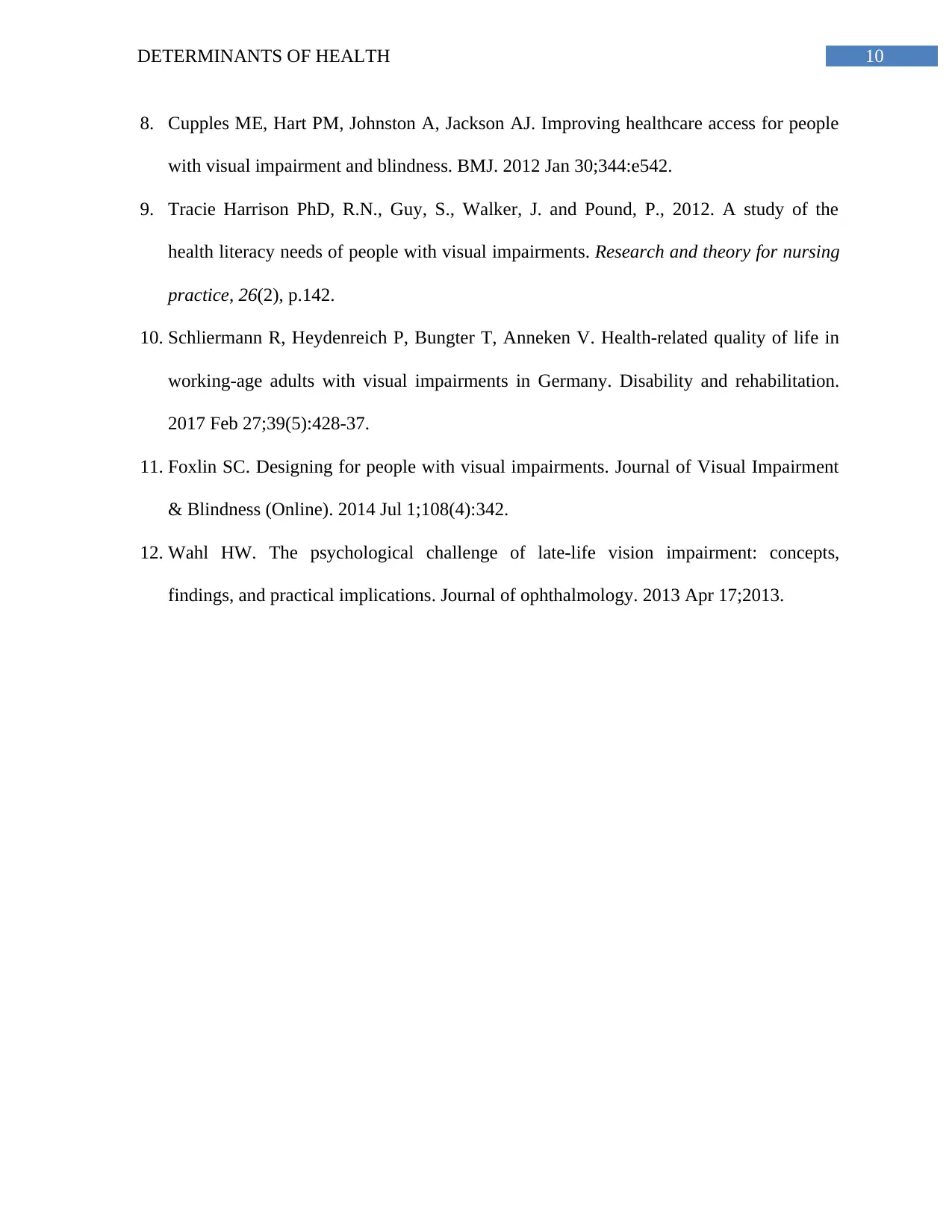
10DETERMINANTS OF HEALTH
8. Cupples ME, Hart PM, Johnston A, Jackson AJ. Improving healthcare access for people
with visual impairment and blindness. BMJ. 2012 Jan 30;344:e542.
9. Tracie Harrison PhD, R.N., Guy, S., Walker, J. and Pound, P., 2012. A study of the
health literacy needs of people with visual impairments. Research and theory for nursing
practice, 26(2), p.142.
10. Schliermann R, Heydenreich P, Bungter T, Anneken V. Health-related quality of life in
working-age adults with visual impairments in Germany. Disability and rehabilitation.
2017 Feb 27;39(5):428-37.
11. Foxlin SC. Designing for people with visual impairments. Journal of Visual Impairment
& Blindness (Online). 2014 Jul 1;108(4):342.
12. Wahl HW. The psychological challenge of late-life vision impairment: concepts,
findings, and practical implications. Journal of ophthalmology. 2013 Apr 17;2013.
8. Cupples ME, Hart PM, Johnston A, Jackson AJ. Improving healthcare access for people
with visual impairment and blindness. BMJ. 2012 Jan 30;344:e542.
9. Tracie Harrison PhD, R.N., Guy, S., Walker, J. and Pound, P., 2012. A study of the
health literacy needs of people with visual impairments. Research and theory for nursing
practice, 26(2), p.142.
10. Schliermann R, Heydenreich P, Bungter T, Anneken V. Health-related quality of life in
working-age adults with visual impairments in Germany. Disability and rehabilitation.
2017 Feb 27;39(5):428-37.
11. Foxlin SC. Designing for people with visual impairments. Journal of Visual Impairment
& Blindness (Online). 2014 Jul 1;108(4):342.
12. Wahl HW. The psychological challenge of late-life vision impairment: concepts,
findings, and practical implications. Journal of ophthalmology. 2013 Apr 17;2013.
1 out of 11
Your All-in-One AI-Powered Toolkit for Academic Success.
+13062052269
info@desklib.com
Available 24*7 on WhatsApp / Email
![[object Object]](/_next/static/media/star-bottom.7253800d.svg)
Unlock your academic potential
Copyright © 2020–2025 A2Z Services. All Rights Reserved. Developed and managed by ZUCOL.


